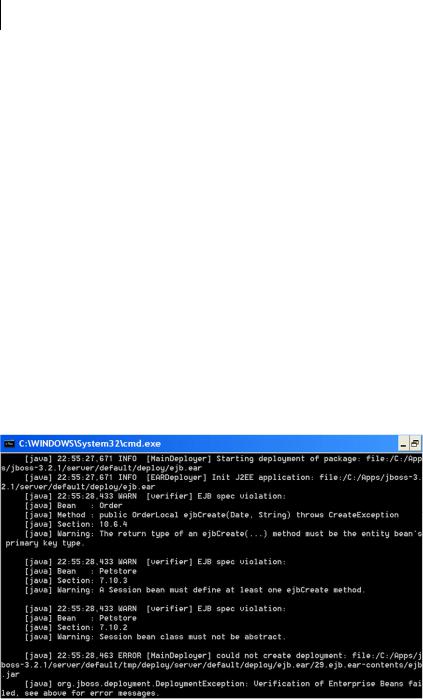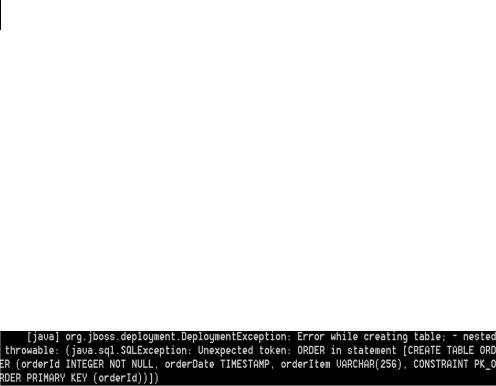
- •contents
- •preface
- •acknowledgments
- •about this book
- •Special features
- •Best practices
- •Design patterns in action
- •Software directory
- •Roadmap
- •Part 1: JUnit distilled
- •Part 2: Testing strategies
- •Part 3: Testing components
- •Code
- •References
- •Author online
- •about the authors
- •about the title
- •about the cover illustration
- •JUnit jumpstart
- •1.1 Proving it works
- •1.2 Starting from scratch
- •1.3 Understanding unit testing frameworks
- •1.4 Setting up JUnit
- •1.5 Testing with JUnit
- •1.6 Summary
- •2.1 Exploring core JUnit
- •2.2 Launching tests with test runners
- •2.2.1 Selecting a test runner
- •2.2.2 Defining your own test runner
- •2.3 Composing tests with TestSuite
- •2.3.1 Running the automatic suite
- •2.3.2 Rolling your own test suite
- •2.4 Collecting parameters with TestResult
- •2.5 Observing results with TestListener
- •2.6 Working with TestCase
- •2.6.1 Managing resources with a fixture
- •2.6.2 Creating unit test methods
- •2.7 Stepping through TestCalculator
- •2.7.1 Creating a TestSuite
- •2.7.2 Creating a TestResult
- •2.7.3 Executing the test methods
- •2.7.4 Reviewing the full JUnit life cycle
- •2.8 Summary
- •3.1 Introducing the controller component
- •3.1.1 Designing the interfaces
- •3.1.2 Implementing the base classes
- •3.2 Let’s test it!
- •3.2.1 Testing the DefaultController
- •3.2.2 Adding a handler
- •3.2.3 Processing a request
- •3.2.4 Improving testProcessRequest
- •3.3 Testing exception-handling
- •3.3.1 Simulating exceptional conditions
- •3.3.2 Testing for exceptions
- •3.4 Setting up a project for testing
- •3.5 Summary
- •4.1 The need for unit tests
- •4.1.1 Allowing greater test coverage
- •4.1.2 Enabling teamwork
- •4.1.3 Preventing regression and limiting debugging
- •4.1.4 Enabling refactoring
- •4.1.5 Improving implementation design
- •4.1.6 Serving as developer documentation
- •4.1.7 Having fun
- •4.2 Different kinds of tests
- •4.2.1 The four flavors of software tests
- •4.2.2 The three flavors of unit tests
- •4.3 Determining how good tests are
- •4.3.1 Measuring test coverage
- •4.3.2 Generating test coverage reports
- •4.3.3 Testing interactions
- •4.4 Test-Driven Development
- •4.4.1 Tweaking the cycle
- •4.5 Testing in the development cycle
- •4.6 Summary
- •5.1 A day in the life
- •5.2 Running tests from Ant
- •5.2.1 Ant, indispensable Ant
- •5.2.2 Ant targets, projects, properties, and tasks
- •5.2.3 The javac task
- •5.2.4 The JUnit task
- •5.2.5 Putting Ant to the task
- •5.2.6 Pretty printing with JUnitReport
- •5.2.7 Automatically finding the tests to run
- •5.3 Running tests from Maven
- •5.3.2 Configuring Maven for a project
- •5.3.3 Executing JUnit tests with Maven
- •5.3.4 Handling dependent jars with Maven
- •5.4 Running tests from Eclipse
- •5.4.1 Creating an Eclipse project
- •5.4.2 Running JUnit tests in Eclipse
- •5.5 Summary
- •6.1 Introducing stubs
- •6.2 Practicing on an HTTP connection sample
- •6.2.1 Choosing a stubbing solution
- •6.2.2 Using Jetty as an embedded server
- •6.3 Stubbing the web server’s resources
- •6.3.1 Setting up the first stub test
- •6.3.2 Testing for failure conditions
- •6.3.3 Reviewing the first stub test
- •6.4 Stubbing the connection
- •6.4.1 Producing a custom URL protocol handler
- •6.4.2 Creating a JDK HttpURLConnection stub
- •6.4.3 Running the test
- •6.5 Summary
- •7.1 Introducing mock objects
- •7.2 Mock tasting: a simple example
- •7.3 Using mock objects as a refactoring technique
- •7.3.1 Easy refactoring
- •7.3.2 Allowing more flexible code
- •7.4 Practicing on an HTTP connection sample
- •7.4.1 Defining the mock object
- •7.4.2 Testing a sample method
- •7.4.3 Try #1: easy method refactoring technique
- •7.4.4 Try #2: refactoring by using a class factory
- •7.5 Using mocks as Trojan horses
- •7.6 Deciding when to use mock objects
- •7.7 Summary
- •8.1 The problem with unit-testing components
- •8.2 Testing components using mock objects
- •8.2.1 Testing the servlet sample using EasyMock
- •8.2.2 Pros and cons of using mock objects to test components
- •8.3 What are integration unit tests?
- •8.4 Introducing Cactus
- •8.5 Testing components using Cactus
- •8.5.1 Running Cactus tests
- •8.5.2 Executing the tests using Cactus/Jetty integration
- •8.6 How Cactus works
- •8.6.2 Stepping through a test
- •8.7 Summary
- •9.1 Presenting the Administration application
- •9.2 Writing servlet tests with Cactus
- •9.2.1 Designing the first test
- •9.2.2 Using Maven to run Cactus tests
- •9.2.3 Finishing the Cactus servlet tests
- •9.3 Testing servlets with mock objects
- •9.3.1 Writing a test using DynaMocks and DynaBeans
- •9.3.2 Finishing the DynaMock tests
- •9.4 Writing filter tests with Cactus
- •9.4.1 Testing the filter with a SELECT query
- •9.4.2 Testing the filter for other query types
- •9.4.3 Running the Cactus filter tests with Maven
- •9.5 When to use Cactus, and when to use mock objects
- •9.6 Summary
- •10.1 Revisiting the Administration application
- •10.2 What is JSP unit testing?
- •10.3 Unit-testing a JSP in isolation with Cactus
- •10.3.1 Executing a JSP with SQL results data
- •10.3.2 Writing the Cactus test
- •10.3.3 Executing Cactus JSP tests with Maven
- •10.4 Unit-testing taglibs with Cactus
- •10.4.1 Defining a custom tag
- •10.4.2 Testing the custom tag
- •10.5 Unit-testing taglibs with mock objects
- •10.5.1 Introducing MockMaker and installing its Eclipse plugin
- •10.5.2 Using MockMaker to generate mocks from classes
- •10.6 When to use mock objects and when to use Cactus
- •10.7 Summary
- •Unit-testing database applications
- •11.1 Introduction to unit-testing databases
- •11.2 Testing business logic in isolation from the database
- •11.2.1 Implementing a database access layer interface
- •11.2.2 Setting up a mock database interface layer
- •11.2.3 Mocking the database interface layer
- •11.3 Testing persistence code in isolation from the database
- •11.3.1 Testing the execute method
- •11.3.2 Using expectations to verify state
- •11.4 Writing database integration unit tests
- •11.4.1 Filling the requirements for database integration tests
- •11.4.2 Presetting database data
- •11.5 Running the Cactus test using Ant
- •11.5.1 Reviewing the project structure
- •11.5.2 Introducing the Cactus/Ant integration module
- •11.5.3 Creating the Ant build file step by step
- •11.5.4 Executing the Cactus tests
- •11.6 Tuning for build performance
- •11.6.2 Grouping tests in functional test suites
- •11.7.1 Choosing an approach
- •11.7.2 Applying continuous integration
- •11.8 Summary
- •Unit-testing EJBs
- •12.1 Defining a sample EJB application
- •12.2 Using a façade strategy
- •12.3 Unit-testing JNDI code using mock objects
- •12.4 Unit-testing session beans
- •12.4.1 Using the factory method strategy
- •12.4.2 Using the factory class strategy
- •12.4.3 Using the mock JNDI implementation strategy
- •12.5 Using mock objects to test message-driven beans
- •12.6 Using mock objects to test entity beans
- •12.7 Choosing the right mock-objects strategy
- •12.8 Using integration unit tests
- •12.9 Using JUnit and remote calls
- •12.9.1 Requirements for using JUnit directly
- •12.9.2 Packaging the Petstore application in an ear file
- •12.9.3 Performing automatic deployment and execution of tests
- •12.9.4 Writing a remote JUnit test for PetstoreEJB
- •12.9.5 Fixing JNDI names
- •12.9.6 Running the tests
- •12.10 Using Cactus
- •12.10.1 Writing an EJB unit test with Cactus
- •12.10.2 Project directory structure
- •12.10.3 Packaging the Cactus tests
- •12.10.4 Executing the Cactus tests
- •12.11 Summary
- •A.1 Getting the source code
- •A.2 Source code overview
- •A.3 External libraries
- •A.4 Jar versions
- •A.5 Directory structure conventions
- •B.1 Installing Eclipse
- •B.2 Setting up Eclipse projects from the sources
- •B.3 Running JUnit tests from Eclipse
- •B.4 Running Ant scripts from Eclipse
- •B.5 Running Cactus tests from Eclipse
- •references
- •index

Using JUnit and remote calls |
319 |
|
|
<abstract-schema-name>Order</abstract-schema-name> <cmp-field>
<field-name>orderId</field-name> </cmp-field>
<cmp-field> <field-name>orderDate</field-name>
</cmp-field> <cmp-field>
<field-name>orderItem</field-name> </cmp-field> <primkey-field>orderId</primkey-field>
</entity>
<message-driven> <ejb-name>OrderProcessor</ejb-name>
<ejb-class>junitbook.ejb.service.OrderProcessorMDB</ejb-class> <transaction-type>Container</transaction-type> <message-driven-destination>
<destination-type>javax.jms.Queue</destination-type> </message-driven-destination>
</message-driven>
</enterprise-beans> <assembly-descriptor/>
</ejb-jar>
Executing ant ear generates the application ear, ready to be deployed in JBoss.
12.9.3Performing automatic deployment and execution of tests
Let’s now modify build.xml (see listing 12.20) to include a deployment target and targets for starting and stopping JBoss.
Listing 12.20 Additional targets in build.xml to deploy the ear and start and stop JBoss
<?xml version="1.0"?>
<project name="Ejb" default="test" basedir=".">
[...]
<property name="src.test.dir" location="${src.dir}/test"/>
[...]
<property name="target.classes.test.dir" location="${target.dir}/classes-test"/>
[...]
<target name="compile.test" depends="compile"> <mkdir dir="${target.classes.test.dir}"/> <javac destdir="${target.classes.test.dir}"
srcdir="${src.test.dir}">

320CHAPTER 12
Unit-testing EJBs
<classpath>
<pathelement location="${j2ee.jar}"/> <pathelement location="${junit.jar}"/>
<pathelement location="${target.classes.java.dir}"/> </classpath>
</javac>
</target>
[...]
<target name="deploy" depends="ear"> <copy todir="${jboss.deploy.dir}"
file="${target.dir}/ejb.ear"/> </target>
<target name="start" depends="deploy">
<java classname="org.jboss.Main" fork="yes"> <jvmarg
value="-Dprogram.name=${jboss.home.dir}/bin/run.bat"/> <arg line="-c default"/>
<classpath>
<pathelement location="${jboss.home.dir}/bin/run.jar"/> <pathelement path="${java.home}/../lib/tools.jar"/>
</classpath>
</java>
</target>
<target name="stop">
<java classname="org.jboss.Shutdown" fork="yes"> <arg line="-s localhost"/>
<classpath>
<pathelement location="${jboss.home.dir}/bin/shutdown.jar"/>
<pathelement path="${java.home}/../lib/tools.jar"/> </classpath>
</java>
<sleep seconds="15"/> </target>
</project>
The deployment is simple and consists of dropping the ear file into the correct JBoss deploy directory. The compile.test target compiles the test classes. You start and stop JBoss by starting a JVM and calling the correct JBoss Java class (JBoss is a Java application).
This code is fine, but you still need a test target that performs the orchestration of all these individual targets.

Using JUnit and remote calls |
321 |
|
|
Creating a test target
In the test target, you need to deploy the ear, call the start target in a separate thread (so you can continue executing build commands), wait for the server to be started, run the tests, and stop JBoss. Fortunately, Ant 1.5+ has a nice parallel task that runs build commands on a separate thread, as shown in listing 12.21. (Note that this code can be further improved using the Ant http and socket tags from the condition task, but doing so is outside the scope of the example.)
Listing 12.21 Adding a test target to build.xml
<target name="test" depends="compile.test">
<parallel>
<antcall target="start"/> <sequential>
<sleep seconds="30"/> <antcall target="run"/>
</sequential>
</parallel>
</target> |
|
|
<target name="runtest"> |
|
|
<junit printsummary="yes" fork="yes" errorproperty="test.error" |
|
b |
|
||
failureproperty="test.failure"> |
|
|
<formatter type="plain" usefile="false"/> |
|
|
<test name="junitbook.ejb.service.TestPetstoreEJB"/> |
|
|
<classpath> |
|
|
<pathelement location="${target.classes.java.dir}"/> |
|
|
<pathelement location="${target.classes.test.dir}"/> |
|
|
<fileset dir="${jboss.home.dir}/client"> |
|
|
<include name="*.jar"/> |
|
|
</fileset> |
|
|
</classpath> |
|
|
</junit> |
|
|
</target> |
|
|
<target name="checktestfailures" if="test.failure"> b |
|
|
<fail>There were test failures</fail> |
|
|
</target> |
|
|
<target name="checktesterrors" if="test.error"> b |
|
|
<fail>There were test errors</fail> |
|
|
</target> |
|
|
<target name="run" depends="runtest,stop,checktesterrors,checktestfailures"> b
</target>

322CHAPTER 12
Unit-testing EJBs
Note that you use the errorproperty and failureproperty attributes of the junit Ant task (b). You use these attributes instead of the more familiar haltonfailure and haltonerror attributes because you want the stop target to be called whatever the outcome of the test, in order to cleanly stop the container.
Verifying deployment
To verify that the application deploys correctly, type ant test and relax. The output is shown in figure 12.5.
NOTE Before you run JBoss 3.2.1 for the first time, you need to edit the server/default/conf/jboss-service.xml file (located in the directory where you installed JBoss) and change the line
<attribute name="RecursiveSearch">False</attribute>
to
<attribute name="RecursiveSearch">True</attribute>
The reason is that JBoss 3.2.1 was shipped with an incorrect value that prevents the JMS services from being deployed correctly. If you don’t make this change, you’ll get a DefaultJMSProvider not bound error when JBoss tries to deploy the OrderProcessorMDB MDB.
Figure 12.5 Boss deployment errors when running the Ant test target
Using JUnit and remote calls |
323 |
|
|
Argh! And you thought the application was working! It doesn’t even deploy! The output shows that you have at least three errors. We say “at least” because errors are like trains—one error can hide another. In practice, there are seven errors, as shown in table 12.2. Note that we purposely didn’t include these errors; they are genuine errors we made when coding the EJB sample. We started by writing the mock-object tests and they ran fine. Then we moved to the integration unit tests and discovered all these errors…. This is a clear demonstration that unit testing in isolation is not enough and needs to be supplemented by either integration unit tests or functional tests.
Table 12.2 Deployment errors uncovered by the integration unit test
Error description |
Fix |
|
|
|
|
OrderEJB implementation of ejbCreate must |
Replace |
|
return the primary key (Integer) and not the bean |
public OrderLocal ejbCreate[...] |
|
interface (OrderLocal). |
||
with |
||
|
||
|
public Integer ejbCreate[...] |
|
|
|
|
OrderEJB implementation of ejbCreate was |
Replace |
|
returning null. It must return the primary key. |
return null; |
|
|
||
|
with |
|
|
return new Integer(uid); |
|
|
|
|
CMP EB fields cannot be primitive types; they must |
Replace |
|
be Java objects. One method of the OrderLocal |
void setOrderId(int orderUId); |
|
interface was using a primitive type. |
||
with |
||
|
||
|
void setOrderId(Integer orderUId); |
|
|
|
|
The createOrder method of the Petstore inter- |
Replace |
|
face wasn’t throwing a RemoteException. This is |
int createOrder([...]); |
|
required for remote methods. |
||
with |
||
|
||
|
int createOrder([...]) |
|
|
throws RemoteException; |
|
|
|
|
The PetstoreEJB session bean was wrongly |
Replace |
|
declared abstract. Only CMP EB classes can be |
public abstract class PetstoreEJB |
|
declared abstract. |
||
implements SessionBean |
||
|
||
|
with |
|
|
public class PetstoreEJB |
|
|
implements SessionBean |
|
|
|
continued on next page

324CHAPTER 12
Unit-testing EJBs
Table 12.2 Deployment errors uncovered by the integration unit test (continued)
Error description |
Fix |
|
|
|
|
The PetstoreEJB class was missing the imple- |
Add |
|
mentation of ejbCreate. This is required for a |
public void ejbCreate() |
|
session bean. |
||
throws CreateException, |
||
|
||
|
RemoteException {} |
|
|
|
|
The create method of the PetstoreHome inter- |
Replace |
|
face wasn’t throwing a RemoteException. This is |
Petstore create() throws |
|
required for remote methods. |
||
CreateException; |
||
|
||
|
with |
|
|
Petstore create() throws |
|
|
CreateException, RemoteException; |
|
|
|
Once all these errors are fixed, you will still stumble across another error, which is difficult to diagnose (see figure 12.6).
Figure 12.6 This error is difficult to diagnose.
What happens is that JBoss automatically creates database tables for your CMP entity beans. However, because the CMP EB is named Order, JBoss generated the following SQL code:
[CREATE TABLE ORDER (orderId INTEGER NOT NULL, orderDate TIMESTAMP, orderItem VARCHAR(256), CONSTRAINT PK_ORDER PRIMARY KEY (orderId))]
That tripped Hypersonic SQL (the default database used by JBoss) because ORDER is a reserved SQL keyword. We had to introduce a jbosscmp-jdbc.xml JBossspecific file to solve this problem (we mapped the Order bean to the Orders table):
<?xml version="1.0" encoding="UTF-8"?>
<!DOCTYPE jbosscmp-jdbc PUBLIC "-//JBoss//DTD JBOSSCMP-JDBC 3.0//EN" "http://www.jboss.org/j2ee/dtd/jbosscmp-jdbc_3_0.dtd">
<jbosscmp-jdbc> <enterprise-beans>
<entity> <ejb-name>Order</ejb-name> <table-name>Orders</table-name>
</entity>
